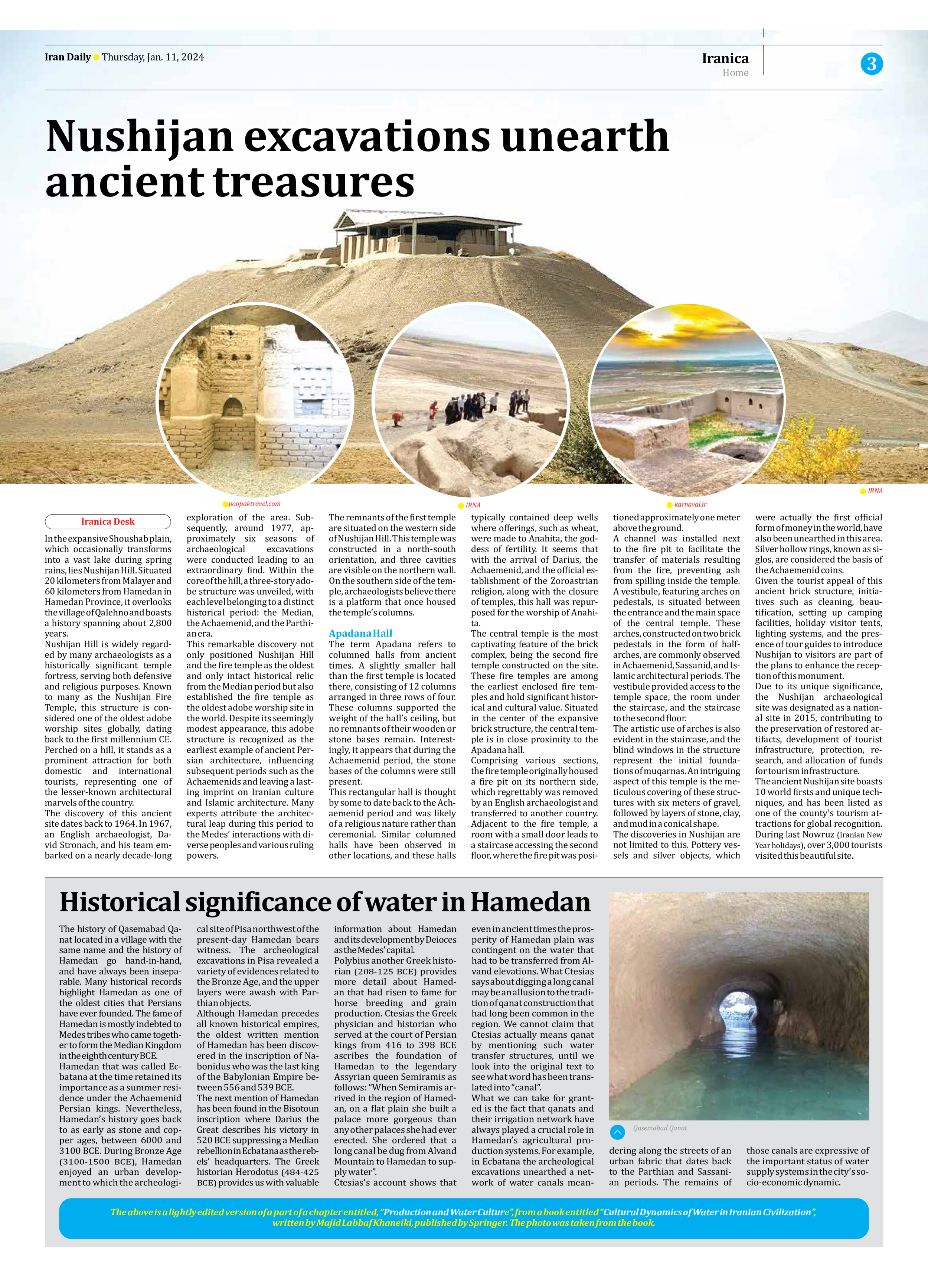
Nushijan excavations unearth ancient treasures
In the expansive Shoushab plain, which occasionally transforms into a vast lake during spring rains, lies Nushijan Hill. Situated 20 kilometers from Malayer and 60 kilometers from Hamedan in Hamedan Province, it overlooks the village of Qalehno and boasts a history spanning about 2,800 years.
Nushijan Hill is widely regarded by many archaeologists as a historically significant temple fortress, serving both defensive and religious purposes. Known to many as the Nushijan Fire Temple, this structure is considered one of the oldest adobe worship sites globally, dating back to the first millennium CE. Perched on a hill, it stands as a prominent attraction for both domestic and international tourists, representing one of the lesser-known architectural marvels of the country.
The discovery of this ancient site dates back to 1964. In 1967, an English archaeologist, David Stronach, and his team embarked on a nearly decade-long exploration of the area. Subsequently, around 1977, approximately six seasons of archaeological excavations were conducted leading to an extraordinary find. Within the core of the hill, a three-story adobe structure was unveiled, with each level belonging to a distinct historical period: the Median, the Achaemenid, and the Parthian era.
This remarkable discovery not only positioned Nushijan Hill and the fire temple as the oldest and only intact historical relic from the Median period but also established the fire temple as the oldest adobe worship site in the world. Despite its seemingly modest appearance, this adobe structure is recognized as the earliest example of ancient Persian architecture, influencing subsequent periods such as the Achaemenids and leaving a lasting imprint on Iranian culture and Islamic architecture. Many experts attribute the architectural leap during this period to the Medes’ interactions with diverse peoples and various ruling powers.
The remnants of the first temple are situated on the western side of Nushijan Hill. This temple was constructed in a north-south orientation, and three cavities are visible on the northern wall. On the southern side of the temple, archaeologists believe there is a platform that once housed the temple’s columns.
Apadana Hall
The term Apadana refers to columned halls from ancient times. A slightly smaller hall than the first temple is located there, consisting of 12 columns arranged in three rows of four. These columns supported the weight of the hall’s ceiling, but no remnants of their wooden or stone bases remain. Interestingly, it appears that during the Achaemenid period, the stone bases of the columns were still present.
This rectangular hall is thought by some to date back to the Achaemenid period and was likely of a religious nature rather than ceremonial. Similar columned halls have been observed in other locations, and these halls typically contained deep wells where offerings, such as wheat, were made to Anahita, the goddess of fertility. It seems that with the arrival of Darius, the Achaemenid, and the official establishment of the Zoroastrian religion, along with the closure of temples, this hall was repurposed for the worship of Anahita.
The central temple is the most captivating feature of the brick complex, being the second fire temple constructed on the site. These fire temples are among the earliest enclosed fire temples and hold significant historical and cultural value. Situated in the center of the expansive brick structure, the central temple is in close proximity to the Apadana hall.
Comprising various sections, the fire temple originally housed a fire pit on its northern side, which regrettably was removed by an English archaeologist and transferred to another country. Adjacent to the fire temple, a room with a small door leads to a staircase accessing the second floor, where the fire pit was positioned approximately one meter above the ground.
A channel was installed next to the fire pit to facilitate the transfer of materials resulting from the fire, preventing ash from spilling inside the temple. A vestibule, featuring arches on pedestals, is situated between the entrance and the main space of the central temple. These arches, constructed on two brick pedestals in the form of half-arches, are commonly observed in Achaemenid, Sassanid, and Islamic architectural periods. The vestibule provided access to the temple space, the room under the staircase, and the staircase to the second floor.
The artistic use of arches is also evident in the staircase, and the blind windows in the structure represent the initial foundations of muqarnas. An intriguing aspect of this temple is the meticulous covering of these structures with six meters of gravel, followed by layers of stone, clay, and mud in a conical shape.
The discoveries in Nushijan are not limited to this. Pottery vessels and silver objects, which were actually the first official form of money in the world, have also been unearthed in this area. Silver hollow rings, known as siglos, are considered the basis of the Achaemenid coins.
Given the tourist appeal of this ancient brick structure, initiatives such as cleaning, beautification, setting up camping facilities, holiday visitor tents, lighting systems, and the presence of tour guides to introduce Nushijan to visitors are part of the plans to enhance the reception of this monument.
Due to its unique significance, the Nushijan archaeological site was designated as a national site in 2015, contributing to the preservation of restored artifacts, development of tourist infrastructure, protection, research, and allocation of funds for tourism infrastructure.
The ancient Nushijan site boasts 10 world firsts and unique techniques, and has been listed as one of the county’s tourism attractions for global recognition. During last Nowruz (Iranian New Year holidays), over 3,000 tourists visited this beautiful site.







